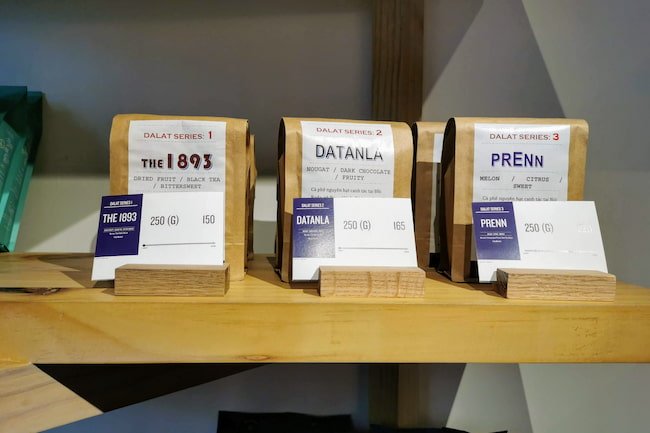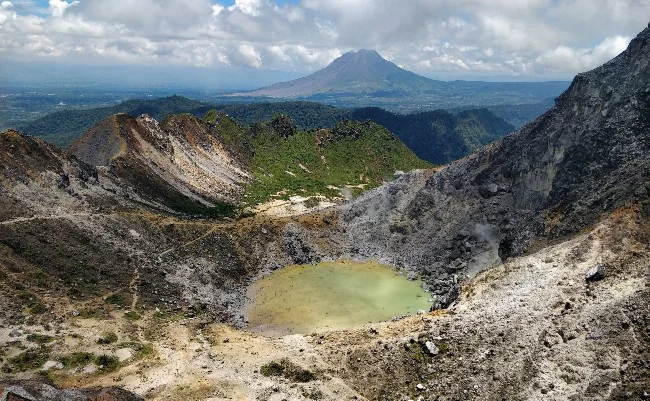Historically, Asian coffee has been overshadowed by beans from East Africa and Central America.
While Ethiopia and Panama will likely remain favorites among coffee snobs for years to come, exciting developments are happening in Asia at the moment.
In recent years, Asian countries have taken an enormous leap forward when it comes to both coffee culture and production.
This has been demonstrated by a new wave of barista and latte art champions from Japan, Taiwan, China, South Korea, Thailand & Malaysia.
However, this increased focus on coffee culture and consumption has also carried over into a more focused effort in producing stand-out coffee.
Here are some Asian coffee countries that are worth keeping an eye on.
1. Indonesia

Common varieties: Typica, Catimor, Caturra, S-795, S-288, Timor, Robusta
Interesting fact: The expensive but controversial kopi luwak (civet coffee) originated here.
Currently ranked 4th in the Top Coffee-Producing Countries in the World, Indonesia has made a stamp with its strong presence locally and abroad.
Indonesia’s flavor profile—especially that of Sumatran coffee—is what often comes to mind when people mention “Asian coffee.” For a good reason: coupled with Indonesia’s mountainous and varied terrain that grows high-quality arabicas, most farmers also employ a specific processing method known as giling basah (aka wet hulling), resulting in a coffee with a distinct earthy and woody profile.
However, you can find specialty-grade washed and natural processed coffee in Indonesia as well. It’s a huge country boasting very diverse coffee regions. In that sense, a washed Sulawesi will taste quite different from a wet-hulled coffee from the Northernmost Aceh province more than 1800 miles away.
If you want to dig deeper into the mysteries of Indonesian coffee, then check out this blog post about Sumatra coffee.
2. Vietnam

Common varieties: Catimor, Bourbon, Robusta
Interesting fact: The Vietnamese government designated December 10 as the country’s national coffee day.
Vietnam is the 2nd biggest coffee producer in the world after Brazil. However, up to 97% of the coffee production comprises lower-quality robusta used for commercial coffee production. Its government shows support through heavily investing in research and creating numerous initiatives for growers and processors alike. By doing so, Vietnam is poised to maintain its status as a global coffee powerhouse for many years to come.
For a country known for its massive export of robusta, it’s easy to overlook the quality of the coffee they actually produce. However, the Central Highlands—a famous coffee-growing region in Vietnam—is long known for the sweetness and strength of their coffee. Vietnamese researchers have also developed new varieties of robusta and arabica that gather over 70 and 80 points; respectively, both considered high-quality according to SCA standards.
3. India
Common varieties: Kent, S.795, Cauvery (catimor), Selection 9, Typica, Robusta
Interesting fact: The S.795 varietal is one of the few arabica varieties with Liberica genetics
Home of spices, India is also celebrated for its shade-grown and monsooned coffees. The country’s domestic market has yet to develop an affinity for drinking coffee, but it is widely enjoyed by Europeans, the country’s biggest export market. In addition to the coffee-growing regions and storage practices that lend Indian coffees their distinct profile, intercropping is also widely practiced. Indian coffees are intercropped with spices, including cinnamon, clove, and nutmeg.
India ranks 7th worldwide for the biggest coffee production. However, this has come at the price of clearing areas in the Western Ghats mountain range to make way for more coffee plantations. With the area already considered a biodiversity hotspot, this can mean a balancing act for the industry to conserve the environment while still making room for coffee.
4. China

Common varieties: Catimor, Bourbon, Typica, Robusta
Interesting fact: Pu’er—an area in Yunnan renowned for its tea leaves—is now growing coffee alongside them.
It can be hard to imagine how a nation steeped in tea-drinking culture exploded into the coffee scene in a span of just a few decades. It was not easy for coffee to take root when it was brought to the mainland by French missionaries in the late 19th century. Not even the government succeeded with its initiative to revive the coffee sector in the sixties. However, in 1988, assisted by the United Nations Development Program and the World Bank, the Chinese government finally succeeded in developing coffee production on a large scale.
With the massive increase in production in recent years, China’s export levels have also grown—huge enough to enter the upper ranks of coffee producers worldwide. The majority of coffee cultivation is in the Yunnan province, whose high altitude and terrain are suitable for growing arabica. The boom in the Chinese economy gave rise to consumers with disposable income and eagerness to upgrade their lifestyles. Coffee businesses took advantage of this as thousands of coffee shops popped up and became go-to places for new experiences, especially for the younger generation. As the growing cafe culture exposes more Chinese consumers to higher quality coffees, the specialty market is now gearing up to meet this demand
5. Papua New Guinea
Common varieties: Typica, Arusha, Mundo Novo, Catimor, Caturra, Robusta
Interesting fact: The first coffee brought to PNG is the famed Jamaican Blue Mountain.
This prized origin adored by coffee patrons globally is also responsible for the income of around three million Papua New Guineans. Even with palm oil being the country’s top agricultural export, coffee is still the main cash crop for farmers in the growing regions.
In contrast to vast coffee plantations and estates in other producing countries, PNG relies on smallholder farmers and their coffee gardens to produce about 85% of its annual coffee crops. This small-scale nature of their production and deteriorated farm-to-market roads are just some of the hurdles limiting the country’s coffee production for years.
6. Laos
Common varieties: Catimor, Typica, Robusta
Interesting fact: Traditional cafe Lao brewed in a cloth filter sock is usually served with a side of green tea.
This is a country whose coffee history has been fraught with natural and man-made disasters: from frost and orange rust disease to the heavy bombings of the Vietnam war. Even today, farmers are limited from expanding coffee production because much of the rich mountainous region suitable for growing coffee is still littered with unexploded bombs from the war. Clearing operations are underway, but this still poses a real danger to the rural communities who rely on the land for their livelihood.
Even with this disadvantage, the Laotian coffee industry has managed to recover. It is now one of the top coffee producers in Asia, mainly exporting robusta. Arabica coffee is still grown on a smaller scale but is continually promoted by their national government to improve farmer incomes.
7. Thailand

Common varieties: Catimor, Typica, Bourbon, Caturra, Catuai, Robusta
Interesting fact: In the 70’s and 80’s many areas previously producing opium were incentivized to switch to coffee production.
Thailand’s unique coffee culture: its local specialty coffee scene fueled by Thai arabica is bristling and vibrant but only slowly starting to get international recognition.
The late Thai king Bhumibol and his Royal Project Foundation have been instrumental in making coffee a cash crop in mountain areas previously notorious for opium production.
Most Thai coffee is consumed domestically and is only rarely exported. This is due to a very high import tariff on international beans. This policy has helped kickstart coffee production in Thailand and created a local sense of pride. However, it’s a two-edged sword since it also means that Thai coffee is currently unable to compete in the international market.
The southern regions of Thailand mainly grow robusta, while arabica is almost exclusively grown in the northern regions.
8. Philippines
Common varieties: Typica, Robusta, Liberica, Excelsa
Interesting fact: Kapeng Alamid is the Philippine version of the civet coffee.
The Philippines is unique since it’s growing both arabica, robusta, liberica, and excelsa (a variant under liberica); however, most of its export is still robusta. With its long history in coffee dating back to the 18th century, the Philippines was at one point the world’s top coffee producer. But, unfortunately, the coffee rust’s arrival in the country and the pest infestation crippled production, and the coffee industry has never fully recovered ever since.
Even with immense challenges currently facing local coffee production, domestic consumption is still growing. So while locals enjoy sipping on kapeng barako (liberica), this also opens up an opportunity for the country’s young specialty coffee market to address that increasing demand (and some of them already have!). The coffee industry roadmap set up by the national government to revitalize the sector is still ongoing, but private organizations and local farmers are helping each other and doing what they can in the meantime.
9. Yemen
Common varieties: Typica, Bourbon, Yemenia
Interesting fact: Old-fashioned millstones used to grind beans are still turned manually by camels and donkeys.
Many people don’t think about Yemen as an Asian origin, but technically it is. Rivaling Ethiopia in its long-standing coffee tradition and history, Yemen produces highly sought-after beans that have only become rarer because of the ongoing civil war. It is generally believed that coffee was first cultivated widely in Yemen after being exported from its birthplace, Ethiopia. With the production commercialized in the 16th century, Yemen became the world’s sole coffee exporter and influenced the emergence of coffee cultures across Europe and the Arab empire.
In recent years, Yemen has slowly made a comeback in the collective mind of coffee connoisseurs. Amid the outbreak of wars, severe water shortage, and temptation of other more lucrative crops, many Yemeni farmers—inspired by the resounding commercial success of the Port of Mokha brand — are striving to revive the coffee sector.
More recently, the news about a genetically separate coffee family native to Yemenia has sparked even more international demand for coffee from this ancient origin.
10. Malaysia

Common varieties: Liberica, Robusta
Interesting fact: Local kopitiams or coffee shops serve a blend of robusta and liberica coffee that has been roasted with margarine and sugar.
Perhaps the least popular Asian coffee origin on this list, Malaysia is indeed a major coffee producer—just not the kind of coffee people have come to expect. While the country’s geography is not favorable for growing arabica, it is one of the few nations that mainly cultivates liberica. However, due to the low global demand for this type of coffee, Malaysia has not fully cemented itself in the coffee industry.
This has been changing in the past few years with the government investing in the liberica coffee-growing potential of Sarawak (a Malaysian state part of Borneo island). As a result, specialty coffee shops have also sprung up in the region, showcasing liberica and re-educating consumers in the process. In the Johor region, where most liberica is grown, a small coffee farm known as My Liberica stands as a pioneer in producing specialty liberica in the country. Producers and roasters follow suit as they experiment with different methods to explore liberica’s mostly untapped flavor potential further.
Further Reading: The Best Coffee Beans in the World
